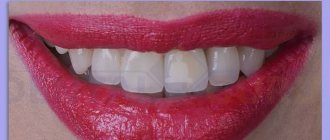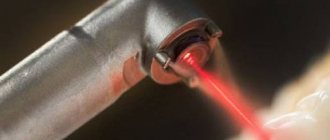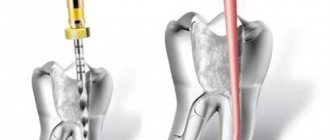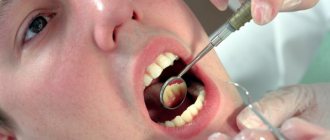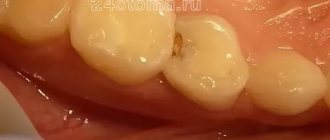Indications for filling
Installing a seal will help if you have the following problems:
- caries of enamel and dentin (medium and deep stages);
- loss of a previously installed filling;
- tooth injury (not affecting the root part).
Filling can be carried out as planned (the patient himself plans the time to see a doctor as damage is discovered) or urgently (as a result of acute pain syndrome).
A so-called temporary filling is usually installed urgently (unscheduled). Medicine is placed into the tooth cavity, which relieves pain and inflammation, and also prepares the cavity for further treatment and installation of a permanent filling.
Depending on the extent of the damage, treatment may be:
- fast - in one session;
- multi-stage - in several approaches (for example, when working with dental canals).
Laser in dentistry
There are several types of dental laser: diode, argon, neodymium, erbium, carbon dioxide. The difference between the devices is in power, wavelength, point or constant flow of pulses. Each type of laser beam is used for specific procedures. It is used with equal success for therapeutic treatment and surgical intervention.
Preparation for filling
During the preliminary consultation, the dentist conducts a full examination of the dentition, during which he identifies the main areas of damage. In advanced cases, he may prescribe an x-ray of a separate area or an orthopantomogram to obtain a general picture of the condition of the dental canals.
Further preparation for filling comes down to hygienic procedures. If the damage prevents you from brushing your teeth normally using a toothbrush, it is recommended to rinse your mouth using bactericidal rinses. This will simplify the process of disinfecting the oral cavity in preparation for filling.
Sedation
“Calm, just calm!” This is the motto of anyone who crosses the threshold of a dental office. To do this, you can take a mild sedative (valerian, motherwort) or drugs with similar effects in advance (preferably after prior consultation with your doctor).
Anesthesia
It is mandatory if the teeth are damaged deeper than the enamel level. To do this, they mainly use injectable local anesthetics, which are injected into the area where the problem tooth is located. The start time for a standard injection drug is 15-20 minutes from the moment of administration.
If the damage extends only to the enamel, the treatment procedure does not require drug anesthesia of the nerve endings of the tooth, however, for people with hypersensitivity, as a rule, an exception is made.
In severe cases and with severe psychological instability, the patient may choose general anesthesia.
What kind of dentist treats teeth and puts fillings?
There are several specialized areas in dentistry. Each doctor solves specific problems of the dental system. Therefore, it is necessary to know who treats certain diseases, including which dentist treats caries and places fillings.
Which dentist treats caries?
In dental practice, 3 specialists can fill teeth at once:
- Dentist;
- therapist;
- pediatric dentist.
The job description of the first professional includes a wide range of responsibilities. He chooses treatment tactics, administers anesthesia, diagnoses, prevents and treats caries. However, this specialization does not require lengthy training in higher education institutions.
Important! Today, the profession of a dentist is considered obsolete. Their main responsibilities are handled by junior medical staff. Therapists are responsible for diagnosis and treatment.
A dentist-therapist is a general specialist.
The pediatrician can also place fillings. However, its focus is the elimination of oral diseases in children.
The dentist-therapist is the first one who receives and examines the patient. This is a generalist. If only conservative intervention is required, it will be handled by a therapist. But when specific therapy is needed, he will refer you to another doctor: an orthodontist, a prosthetist, a surgeon, a periodontist.
Additional Information! A dentist of any specialization is familiar with all manipulations. Therefore, it is not always important which doctor puts the fillings. The procedure may be necessary when performing work of a different nature: prosthetics, orthodontic treatment and other manipulations.
Responsibilities of a dental therapist
A dentist-therapist is a specialist with a higher medical education. He is obliged:
- receive and examine patients;
- diagnose;
- draw up a treatment plan;
- administer anesthesia using modern techniques;
- carry out the prevention and elimination of all types of carious lesions and their complications;
- install seals;
- carry out endodontic intervention;
- take impressions, try on, adjust prostheses and orthodontic structures;
- perform simple physiotherapeutic procedures;
- carry out aesthetic and functional restoration, whitening, professional hygiene.
A dental therapist can also diagnose dental diseases.
Additional Information! In addition to basic services, the therapist is required to monitor the condition of the equipment, take and store medications, and teach hygiene to patients. An important point is constant professional development, improvement of professional skills, and introduction of new treatment methods.
It is worth understanding that a dentist-therapist is a general practitioner. In addition to treating diseases of the oral cavity, he can provide emergency medical care, reduce dislocations and fix jaw fractures, and, based on tests, suggest diseases of other human organs and systems. Therefore, you should not resist if the doctor asks permission to perform a manipulation that does not concern dental problems.
Filling procedure
Includes several sequential stages:
- Cleaning the damaged surface from unstable areas and carious formations. In the presence of caries, cleaning the surface is of particular importance: if the surface is not completely cleaned, tooth decay will continue even after the filling is installed.
- Drying of saliva in the working area is carried out using a saliva ejector and cotton swabs (or latex pads), which isolate the tooth from the surrounding soft tissue.
- Surface preparation includes mechanical and antimicrobial treatment. The latter is needed to increase the adhesion of the tooth surface to the finished filling composition. To do this, apply to a cloth cleaned with an antiseptic for 30 seconds. apply a special acid-containing solution. After washing off the solution, the cavity under the filling is thoroughly dried.
- Preparation of filling material and installation of the seal. At this stage, preparations are prepared in accordance with the purpose and type of filling. This can be either a therapeutic temporary filling or a durable composition with a 20-year service life. When installing a permanent filling, the paste is carefully compacted to avoid the formation of tiny bubbles, and after hardening, it is ground and polished to the level of the natural bite. As a result, the tooth acquires its natural shape and healthy functionality.
Cost of services
If treatment is started on the day of treatment, consultation and treatment plan are free
| Surgeon consultation | 550 rub. |
| Permanent tooth extraction is simple | RUR 2,500 |
| Complex permanent tooth extraction (category 1-3) | 4,000 rub.-6,000 rub. |
| Removal with dissection and flap folding | 7,000 rub. |
| Removal of 8th teeth | from 8,000 rub. |
| Opening and draining the abscess | 1,500 rub. |
| Applying (removing) one suture | 300 rub. |
| Removal of a benign neoplasm on the mucous membrane | from 3000-5000 rub. |
| Removal of migratory granuloma | 10,000 rub. |
| Osteotomy, alveolotomy, removal of exostosis 1 tooth | 1,000 rub. |
Channel processing
During deep treatment, filling the dental canals deserves special attention. To do this, the pulp filling it is completely removed, the walls are thoroughly cleaned and ground. This process may take several trips to the doctor and require the installation of a temporary filling.
After treating the cavity with antibacterial compounds, it is filled with a filling mass. If the work is done well, the x-ray should show 100% filling of the entire cavity.
Canal treatment methods
- Depophoresis allows you to qualitatively sterilize the cavity of the dental canal in the presence of cracks, pathological cavities and curvatures. The sterilizing drug is administered using a special instrument that penetrates into the most inaccessible areas of the canal.
- Filling with gutta-percha (cold or hot method) is a simple and reliable solution for filling standard-shaped canals.
- Mummification is the introduction of shock doses of an antiseptic into the pulp area, which completely eliminates the possibility of an inflammatory process.
- Retrograde filling is used in the presence of a special gun with a nozzle, which makes it possible to fill the cavity better.
Is it painful to have a filling?
Many readers remember very well from their own bitter experience how toothache was treated in Soviet times. Modern medicine has made giant leaps forward. So, knowing how teeth are filled now, we are no longer so afraid of going to the dentist. This is why the number of people suffering from toothache who are terrified of sitting in the doctor’s chair has been rapidly decreasing in recent years.
Nowadays, a patient in a good clinic is not even faced with the choice of treating a diseased tooth without or with anesthesia, and the choice of anesthetics is so wide that even an allergy sufferer will not have to suffer from pain. A couple of injections into the gums, and for quite a long time the patient does not experience any pain, and a slight sensitivity after filling, which usually goes away within a maximum of two days, can be relieved by modern painkillers or traditional medicine.
Filling material
There are two main types of fillings used in dentistry: temporary and permanent.
Temporary fillings are installed for diagnostic and therapeutic purposes for several days or weeks. They are used to preserve dental pulp, restore dentin, relieve inflammation or eliminate the dental nerve using special chemical compounds.
A permanent filling is placed with the expectation of long-term service and is designed to completely restore the functionality of the tooth and its aesthetics (especially important for the front incisors).
Types of fillings:
- by material composition (cement, metal, composite, photopolymer, compomer, ceramic);
- according to the method of hardening (light, chemical hardening);
- at the place of application (for the coronal part, when filling canals).
The most important thing is the choice of filling material.
Cements are the most affordable materials. They are used less and less often for filling permanent teeth, but the content of fluoride ions in some compositions makes them relevant for protecting against recurrent caries of both milk and permanent teeth.
Metal fillings (amalgams) are alloys based on various metals (silver, copper, mercury). Such materials do not perform an aesthetic function, therefore they are used for filling only molars, but they are quite wear-resistant and affordable.
Composite and photopolymer materials are the optimal choice of modern dentistry. Unlike cement, they allow you to create reliable, long-lasting fillings. Unlike amalgam material, they combine well with natural fabrics.
The top of the range of filling materials are ceramic and compomer fillings - the most expensive, but most durable samples.
They do not shrink and are able to completely merge with tooth tissue without changing color over time. Non-toxic, do not destroy tissue and do not require special care.
How much do the products cost?
Which fillings are best to install based on their cost? It seems that the only correct answer to this question is that all good things come at a price. However, this is not so; in each specific case, one must start from specific features, and only they will dictate the future price of the filling.
However, in order to get at least a little orientation in the pricing policy, you should know that inlays cost in the range of 3000-14000 rubles, compomers from 650 to 1000 rubles, chemically cured composites from 600 to 800 rubles.

